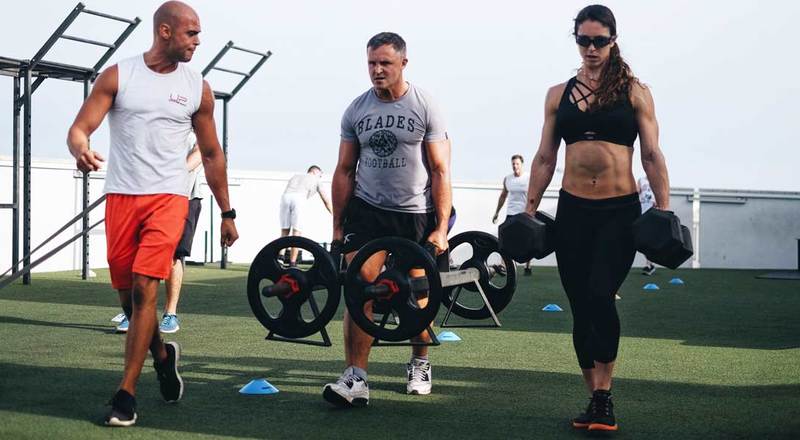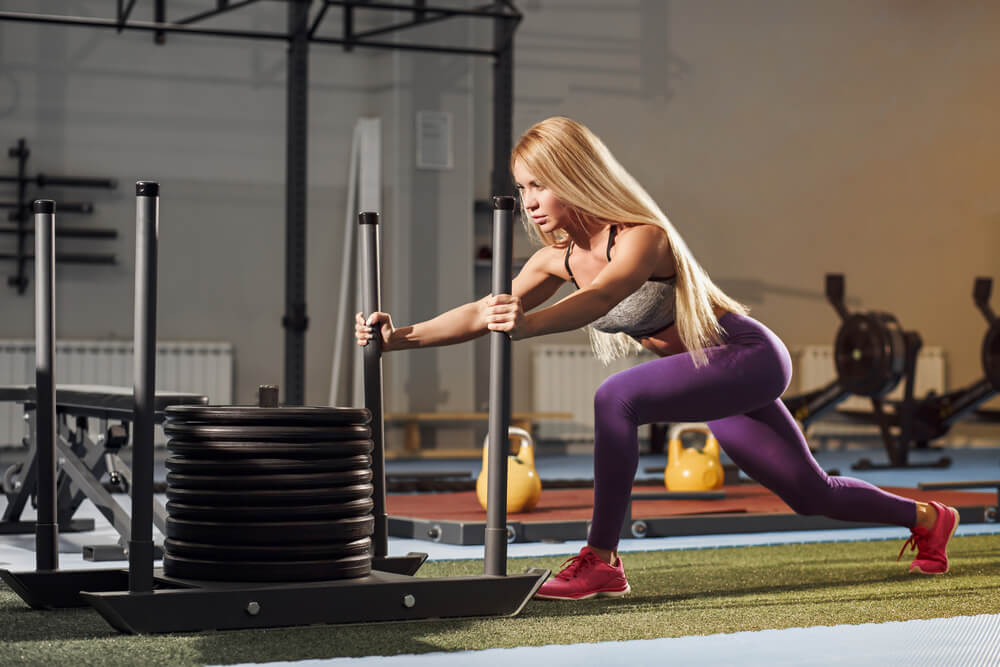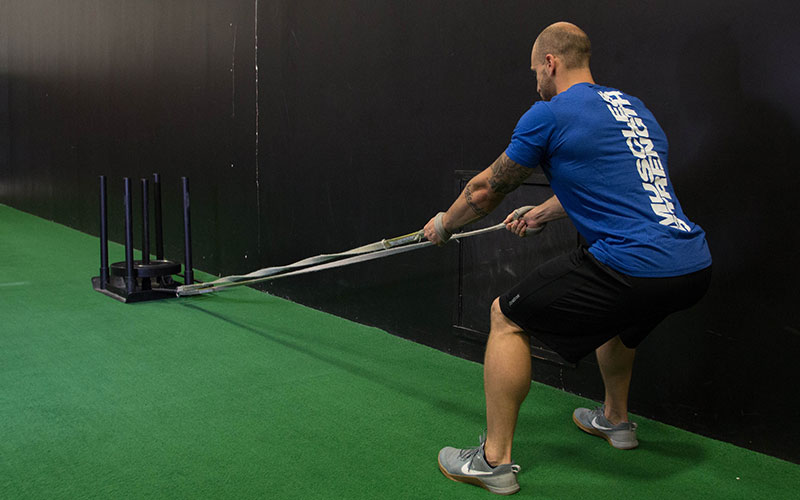7 Best Strongman Moves for Fat Loss and Conditioning
Strongman exercises are some of the best tools for improving performance and body composition we have at UP.
We all know interval and resistance training are some of the fastest, most effective ways to burn fat and build muscle. Because of that, we have invested in a wide variety of different conditioning equipment to help our clients get the fastest results possible.
Prowlers, sleds and farmers walks are a mix of resistance and interval training, for brutally hard conditioning workouts.
Commonly referred to as ‘modified strongman’ training, the exercises you’ll find here are some of the most effective fat loss tools in the Ultimate Performance arsenal.
We use them day in and day out to produce our dramatic transformations.
Modified strongman training has a big impact on anaerobic fitness levels, which then helps improve recovery during your resistance training programme.
These strongman moves are predominantly concentric, so it is easier to recover from despite being one of the toughest and most effective conditioning methods for improving body composition.
On top of being excellent tools for physique transformation, we also use many of these exercises to help boost athletic performance and rehabilitate injury – we’ll look at all the key benefits of each exercise and its execution.

1. Prowler Push
Execution
The prowler is infamous here at Ultimate Performance. It’s a great finisher and allows you to push yourself to the limit, safely. Max out on a treadmill and you fall off; max out on a prowler and you just get slower.
The hands should be placed high on the bars, and you must stay up on your toes as you sprint. A big mistake people often make when using the prowler is placing their feet flat on the floor and just grinding like they are walking uphill. This is wrong. It should be a sprint – as fast as you can – and you can’t sprint with flat feet.
Benefits
The prowler targets the quads and calves, though the resistance is going to be pretty submaximal if you are using a weight that allows you to sprint. As with all of these exercises, in a calorie deficit, it will help with fat loss.
The prowler can also help develop explosive power in the lower body as you sprint against resistance. Because of the accumulation of lactic acid in the legs, it’s a great exercise for developing your lactate threshold.

2. Prowler Push Heavy
Execution
You can also use the prowler with a heavy load. The load should be heavy enough that it’s difficult to even get it moving at the start. You must stay up on the toes, and the focus here will be on small, fast steps or you’ll lose momentum and slow to a stop.
You’d better have training shoes with a good amount of grip on the bottom for this one! Done for one length of a track, the heavy push should be a serious grind.
Benefits
The heavy prowler targets slightly more glute (though still loads of quad and calf) because you’ll need to be more horizontal to the floor, resulting in a bigger bend at the hip each time you drive the knees through.
It’s going to build much more strength in the lower body than the standard sprint on the prowler because of the load. It may have less application to explosiveness because of this, however.
3. Backwards Sled Drag
Execution
The standard technique here is with a slight lean backwards, planting the toes first and driving backwards with alternating steps.
If you keep the weight quite light, you should be able to remain on the balls of your feet through the entire movement.
If the weight is heavy, then you should still plant the balls of your feet first, but then go toe to heel. In both cases, you need to move your feet as fast as you can.
It’s important to make sure the feet don’t start pointing outward like a duck – they should stay straight forward.
Finally, everything above the waist needs to stay still. Once fatigue kicks in, it’s very tempting for the upper body to start rocking side to side to aid those burning quads. To avoid this completely, you can attach the weight to a dipping belt around your waist instead.
Benefits
The backwards sled drag produces exceptionally high levels of lactic acid. You can keep going long after that burn kicks in and this makes it an excellent finisher, like the prowler.
With the lighter weight (up on the toes) the quads and calves are the focus. When the weight is heavy, and the heels start hitting the floor, then you’ll recruit more posterior chain, particularly the glutes.
The backwards sled drag may also help rehabilitate injuries due to the low impact and high repetitions, helping to strengthen the muscles around the knee. As with all injuries, consult a trained professional first.

4. Sled Rope Drag
Execution
This exercise can be performed either seated or standing. If it is seated, then you may need something solid to brace your feet against. In both cases, feet should be square on the floor, not in a staggered stance which may overload one side of the body.
Aim to pull hand over hand rather than walking the hands down the rope and pulling with both hands at the same time.
It’s okay to allow the body to rotate a little as you pull, but it shouldn’t be excessive. If the rope starts to sway from left to right then, you’re rotating too much.
Benefits
The sled rope drag targets the back and arms. If performed seated it is even more isolated for the upper body. As with all these exercises, this produces high lactic acid levels.
However, your arms will generally fatigue faster than the legs, meaning you’re more likely to burn out early.
The sled rope drag, therefore, is a great exercise to superset with a lower body exercise for maximum lactic acid levels in the body.
This exercise is particularly beneficial for people in sports that require a lot of upper body strength and endurance such as grappling sports and Mixed Martial Arts. It builds great endurance and strength in the back while also having positive impacts on gripping ability.
5. Squat to High Pull with Sled
Execution
Usually performed with long handles attached to the sled, the weight needs to be heavy. Walk back until you’re leaning slightly against the weight squatting back into the heels with arms extended. Forcefully explode up out of the squat and at the same time row the hands up toward the ears. Take a couple of steps back to take the slack and then repeat. Those steps back need to be quick and purposeful; it should not be an opportunity to have a little rest.
Imagine driving through the glutes and extending the hips as you extend through the squat.
The goal is to use the explosive force of this extension, combined with the row, to get the sled gliding toward you along the floor. If the weight is too heavy, the weight will stop as soon as your squat reaches full extension. If the weight is too light, you’ll hit yourself in the feet with the sled, so it’s important to find the right balance.
Benefits
Less isolated than many of the exercises we’ve looked at so far, this exercise is a great all-round posterior chain exercise. Strengthening the muscles of the upper back and lower back, as well as the glutes and hamstrings.
This exercise will get the heart rate up fast because of the global muscle recruitment – it’s training both upper and lower body at the same time. This makes it a great calorie burner.
6. Forward Sled Drag
Execution
The forward sled drag can be performed either holding straps with the hands behind you or braced up on your shoulders or alternatively strapped to the shoulders/waist with a harness.
Starting from either an upright stance (usually) you must accelerate the weight as fast as possible.
The weight should be very light. Focus on the acceleration and driving the knees up and through, through the entire distance like performing a maximal 100m sprint start.
Benefits
Other than raising the heart rate rapidly, this exercise would be a great accompaniment to athletes who need a high degree of explosive power. It is not suitable for developing power for running sports that require a high degree of technique, however. This is because the extra load will interfere with running mechanics.
It’s a great inclusion on this list because it’s another exercise that recruits good amounts of posterior chain, with the glutes and hamstrings helping you accelerate and decelerate on each length.
7. Farmer’s Walks
Execution
These can be performed with dumbbells, but be aware that the weight on either end of the handles will inhibit your leg movement.
As a result, you’ll have to hold them out wide to the side, limiting the load you can carry. As a result, the training effect on the legs will be submaximal. That said, that arm position has its own positives, which we’ll discuss later.
Make sure you ‘deadlift’ the weight up with a straight back before starting your walk. Steps should be normal length or a bit shorter – don’t overstride as the hips will start to rock and become unstable.
Your pace needs to be very fast. Lock the abdominals down tight and each breath taken should be short and sharp with the steps to keep support around the spine.

Benefits
A heavily-loaded farmer’s walk (with farmer’s walk handles) is extremely tough on the grip, stabilising muscles and vastus medialis oblique (VMO) which is essential for knee health.
This makes it great for a wide range of sports as well as building strength around the knees after rehabilitation.
If loading with dumbbells, the exercise will focus more on the shoulder girdle for the reasons above, particularly overloading the traps, and will still have an excellent metabolic effect.